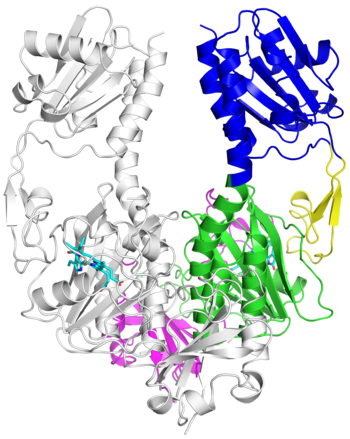With the global population expected to reach 9 billion by 2050, the world's farmers are going to need to produce a lot more food — but without using much more farmland, as the vast majority of the world's arable land is already being used for agriculture.
One possible solution is to try to grow crops more densely in the field, thereby increasing yield per acre. But it's not as easy as just spacing seeds more closely together at planting time.
Packed too tight, for instance, corn plants will grow tall and spindly as they try to outcompete neighboring plants for access to sunlight — a phenomenon known as shade avoidance.
 This illustration shows the 3-D structure of parts of the phytochrome molecule. Image: Richard Vierstra |
"The problem with shade avoidance when it comes to food crops is that the plants are spending all this time and energy making stems so they can grow tall, instead of making food that we eat," explains UW-Madison plant geneticist Richard Vierstra, who is developing a work-around. His team is re-engineering a light-sensing molecule found in plants, known as phytochrome, to allow plants to grow normally even when they're packed in tight.
"Instead of 30 inch rows, this technology could enable us to plant corn in 20-inch rows, boosting yields by as much as 50 percent — if we can get the plants to ignore their neighbors," says Vierstra.
Phytochrome is the main photoreceptor that allows plants to tell when the lights are on and when they're off. It's what tells seeds to germinate and young seedlings to become green, and enables plants to establish circadian rhythms — an internal clock system, says Vierstra. "And it also allows a plant to sense whether it's in full sun or whether it's being shaded by other plants."
In the lab, Vierstra and his scientific team developed the first three-dimensional structures of phytochromes. Using these models, they are now trying to rationally redesign the photoreceptor to have altered light sensing properties. This re-engineering involves creating hundreds of possibly interesting phytochrome mutants, and then testing them for light sensitivity both in the test tube and inside plants.
Already, Vierstra's team has found a number of mutants that are extremely sensitive to light. These mutant phytochrome molecules, if genetically engineered into food crops, could trick the plants into thinking they are getting plenty of light, even when they're growing in a crowded field.
Vierstra is in the process of patenting the technology, and already knows of a large agribusiness company that's eager to help commercialize it.
"We're starting to engineer the phytochrome system in corn, in lines that will eventually be used for breeding," he says. "It's exciting to think about the potential this technology has to boost agricultural productivity."





